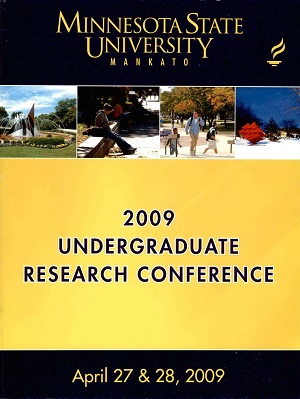Identifying the Specific DNA Sequence that is the Target for Potential Anti-Cancer Agent "SOS"
Location
CSU Ballroom
Start Date
28-4-2009 10:00 AM
End Date
28-4-2009 12:00 PM
Student's Major
Chemistry and Geology
Student's College
Science, Engineering and Technology
Mentor's Name
Danae Quirk Dorr
Mentor's Department
Chemistry and Geology
Mentor's College
Science, Engineering and Technology
Description
Cancer cells are harmful to organisms due to their lack of termination programming. Non-cancerous cells are programmed to terminate after a certain number of replications. Therefore, a possible solution to overcoming the effects of cancerous cells may be to reprogram their DNA to act similar to the termination programming in non-cancerous cells. There has already been some recent research done on agent NSC 652287 (SOS), a compound that has properties that would enable it to achieve this reprogramming in cancer cells. Prior research has shown that SOS does bind to DNA, specifically 2'-deoxyguanosine. The purpose of this project is to determine the specific DNA sequence for which SOS has specificity for. By determining the sequence specificity that SOS has for DNA, pharmaceutical companies will have the additional information they need to prepare more effective anti-cancer drugs. To achieve this goal, several DNA oligonucleotides with defined sequences were treated with SOS. These short segments of DNA then underwent hydrolysis. This broke apart the DNA into its components. However, the location where the SOS bound to the DNA remained intact so that the sequence that it was specific for could be identified. A HPLC was used to separate the components of the mixture. The data collected from the HPLC has been analyzed to locate the sequences of DNA that the SOS agent reacts with. The results from this project identifcd the sequence specificity that SOS has for DNA, and how SOS affects these sequences.
Identifying the Specific DNA Sequence that is the Target for Potential Anti-Cancer Agent "SOS"
CSU Ballroom
Cancer cells are harmful to organisms due to their lack of termination programming. Non-cancerous cells are programmed to terminate after a certain number of replications. Therefore, a possible solution to overcoming the effects of cancerous cells may be to reprogram their DNA to act similar to the termination programming in non-cancerous cells. There has already been some recent research done on agent NSC 652287 (SOS), a compound that has properties that would enable it to achieve this reprogramming in cancer cells. Prior research has shown that SOS does bind to DNA, specifically 2'-deoxyguanosine. The purpose of this project is to determine the specific DNA sequence for which SOS has specificity for. By determining the sequence specificity that SOS has for DNA, pharmaceutical companies will have the additional information they need to prepare more effective anti-cancer drugs. To achieve this goal, several DNA oligonucleotides with defined sequences were treated with SOS. These short segments of DNA then underwent hydrolysis. This broke apart the DNA into its components. However, the location where the SOS bound to the DNA remained intact so that the sequence that it was specific for could be identified. A HPLC was used to separate the components of the mixture. The data collected from the HPLC has been analyzed to locate the sequences of DNA that the SOS agent reacts with. The results from this project identifcd the sequence specificity that SOS has for DNA, and how SOS affects these sequences.
Recommended Citation
Gripentrog, Elizabeth M.. "Identifying the Specific DNA Sequence that is the Target for Potential Anti-Cancer Agent "SOS"." Undergraduate Research Symposium, Mankato, MN, April 28, 2009.
https://cornerstone.lib.mnsu.edu/urs/2009/poster-session-C/27



